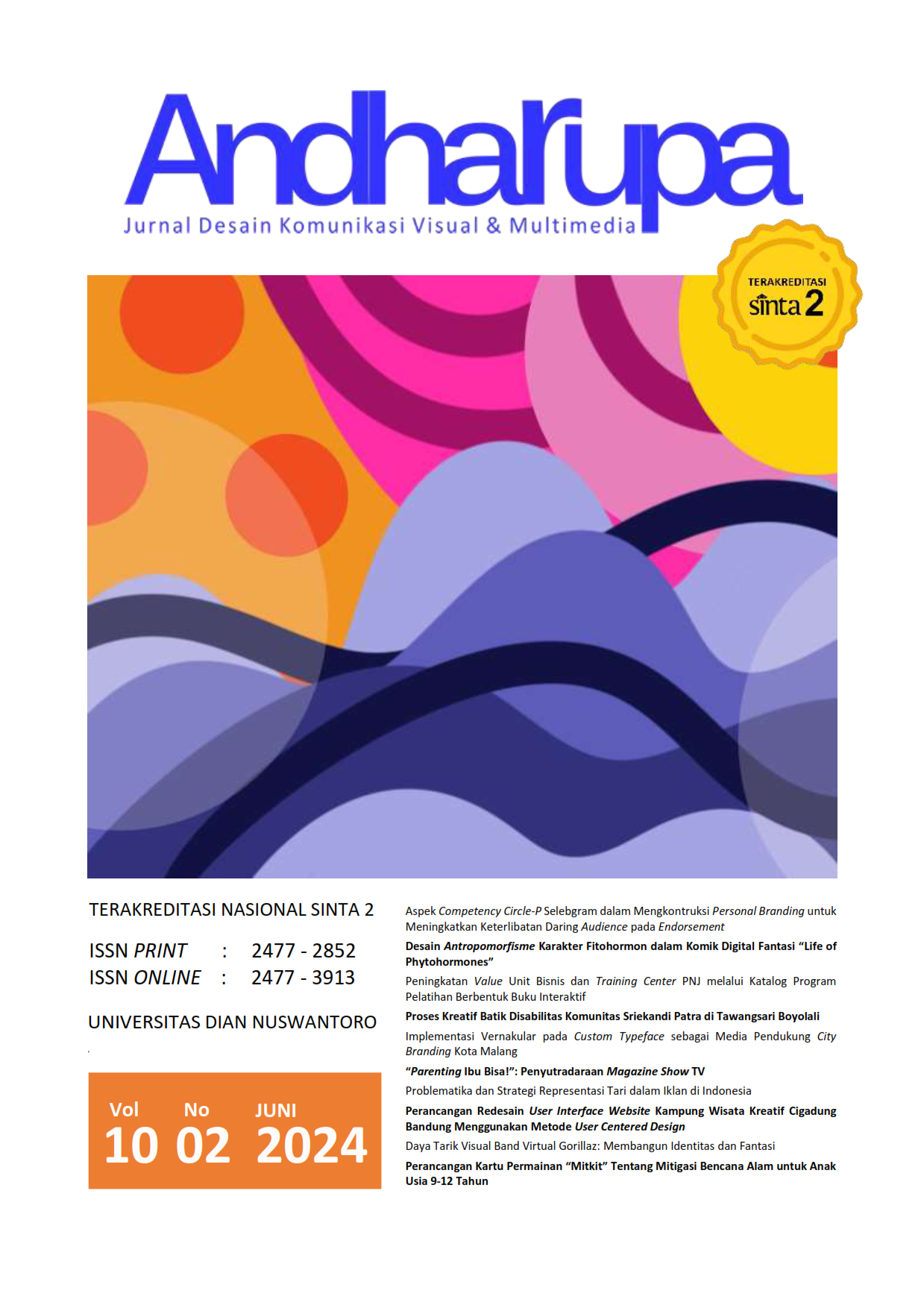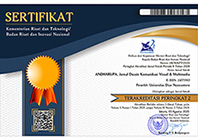DESAIN ANTROPOMORFISME KARAKTER FITOHORMON DALAM KOMIK DIGITAL FANTASI “LIFE OF PHYTOHORMONES”
DOI:
https://doi.org/10.33633/andharupa.v10i02.8035Keywords:
fitohormin, komik, fantasi, antropomorfismeAbstract
Abstrak Biologi adalah ilmu kompleks multidisiplin yang memerlukan pengetahuan kimia, fisika, hingga matematika. Beberapa penelitian juga menunjukkan bahwa materi biologi masih sulit untuk dipahami mempengaruhi pemahaman materi secara jelas dan menimbulkan miskonsepsi kedepannya, salah satunya adalah materi mengenai hormon tumbuhan (Fitohormon). Berdasarkan hal tersebut, muncullah sebuah peluang untuk merancang media yang dapat menjelaskan materi fitohormon secara runtut dan ringan untuk dibaca seperti komik. Komik adalah salah satu bentuk media komunikasi visual dengan gambar dan tulisan yang berguna untuk menyampaikan pesan atau informasi sehingga mudah untuk dimengerti. Pemanfaatan konsep fantasi dari adaptasi antropomorfisme dinilai dapat menyampaikan materi fitohormon secara jelas dan ringan untuk dibaca berbagai kalangan. Komik “Life of Phytohormones” merupakan media hiburan yang menampilkan dunia di dalam tumbuhan dengan memvisualisasikan fitohormon menggunakan konsep adaptasi antropomorfisme sebagai pekerja yang berpenampilan unik dan memiliki tugas berbeda-beda sesuai peran masing-masing fitohormon dalam tumbuhan sesungguhnya. Dalam proses pembuatan karakter, dilakukan beberapa metode seperti literature review, riset eksperimental, dan in-depth interview. Artikel ini akan menjelaskan mengenai proses desain karakter mulai dari sketsa hingga implementasinya dalam komik “Life of Pytohormones” Kata Kunci: fitohormon, komik, fantasi, antropomorfisme. Abstract Biology is a multidisciplinary, complex science that requires knowledge of chemistry, physics, and mathematics. Several studies have also demonstrated that the material in biology remains challenging to comprehend, which can hinder a clear understanding of the subject and lead to future misconceptions, including those related to phytohormones. As a result, an opportunity arose to design media that could explain phytohormones in a coherent and easy-to-read way, like comics. Comics are a visual communication medium with pictures and writing that are useful for conveying messages or information in an eaIt is believed that the use of fantasy concepts from anthropomorphism can effectively convey phytohormones in a clear and light manner, making them accessible to a wide range of readers. "Life of Phytohormones" is an entertainment medium that depicts the world within plants through the adaptation of anthropomorphism, portraying workers with distinct appearances and tasks based on phytohormones. sed on phytohormones. We used several methods, including a literature review, experimental studies, and in-depth interviews, to design the characters. This article will elucidate the process of designing the phytohormone characters, from the initial sketch to their actual implementation in the comic "Life of Pytohormones." Keywords: phytohormones, comics, fantasy, anthropomorphism.References
Aji, D. 2018. Empat tahap design thinking. (Update 30 Januari 2018)
URL: https://darmawanaji.com/empat-tahap-design-thinking/
[Diakses pada 20 Desember 2022]
Dewi, I. R. 2008. Peranan dan fungsi fitohormon bagi pertumbuhan tanaman [Universitas Padjadjaran]. https://pustaka.unpad.ac.id/archives/19297
Epley, N., Waytz, A., & Cacioppo, J. T. 2007. On seeing human: A three-factor theory of anthropomorphism. Psychological Review, 114(4), 864–886.
Indra Purnomo, D. 2021. Double diamond design thinking. (Update 30 Januari 2018) https://www.dwipurnomo.id/double-diamond-design-thinking/
[Diakses pada 20 Desember 2022]
Kamus Besar Bahasa Indonesia. Arti kata antropomorfisme. (Update 2012)
URL: https://kbbi.web.id/antropomorfisme. [Diakses pada 7 Desember 2022]
Kartini. 2017. Identifikasi miskonsepsi mahasiswa biologi UNM pada mata kuliah fisiologi tumbuhan dengan metode CRI. Universitas Negeri Makassar.
Martin, J. 2020. Anthropomorphism character design final project. ArtStation. URL: https://www.artstation.com/artwork/oAAGwJ [Diakses pada 3 januari 2023]
Megawati, S. 2018. Pengaruh ilustrasi dalam hovel genre fantasi terhadap nilai jual. ULTIMART Jurnal Komunikasi Visual, 10(1), 48–55. Universitas Multimedia Nusantara.
Nurmilasari, L. 2013. Pengaruh kegiatan pembelajaran biologi berbasis praktikum terhadap peningkatan keterampilan generik siswa pada pokok bahasan gerak pada tumbuhan di smp negeri 1 ciawigebang kabupaten kuningan. IAIN Syekh Nurjati Cirebon.
Oktaviani, D. D. 2019. Konsep fantasi dalam film. Rekam, 15(2), 125–136. Institut Seni Indonesia Yogyakarta.
Pradina, L. E., & Yuliani. 2020. Profil Miskonsepsi Siswa pada Materi Pertumbuhan dan Perkembangan Tumbuhan Menggunakan Three-Tier Multiple Choice Test. 9(1), 310–318. UNESA Surabaya.
QnA Sains. 2021. Pengertian biologi, sejarah, manfaat dan 59 cabang ilmu biologi.
URL: https://qnasains.com/pengertian-biologi/ [Diakses pada 3 januari 2023]
Siregar, A., & Siregar, D. I. 2021. Analisis evaluasi pengembangan media komik digital pada mata pelajaran ipa sekolah dasar. Jurnal Sistem Informasi, 2(1), 114. Politeknik Negeri Sriwijaya.
Waytz, A., Epley, N., & Cacioppo, J. T. 2010. Social cognition unbound: Insights into anthropomorphism and dehumanization. 58–62.
Zein, A. (2016). Zat pengatur tumbuh tanaman (fitohormon). Edisi pertama. Jakarta. Kencana.
Downloads
Published
Issue
Section
License
Copyright (c) 2024 ANDHARUPA: Jurnal Desain Komunikasi Visual & Multimedia

This work is licensed under a Creative Commons Attribution 4.0 International License.
Authors who publish with this journal agree to the following terms:
- Authors retain copyright and grant the journal right of first publication with the work simultaneously licensed under a Creative Commons Attribution License that allows others to share the work with an acknowledgment of the work's authorship and initial publication in this journal.
- Authors are able to enter into separate, additional contractual arrangements for the non-exclusive distribution of the journal's published version of the work (e.g., post it to an institutional repository or publish it in a book), with an acknowledgment of its initial publication in this journal.
- Authors are permitted and encouraged to post their work online (e.g., in institutional repositories or on their website) prior to and during the submission process, as it can lead to productive exchanges, as well as earlier and greater citation of published work (See The Effect of Open Access).















